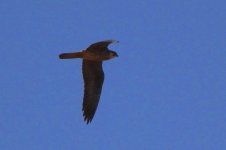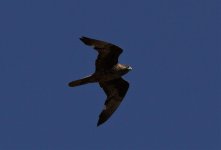Today, like the last days, passerine migrants were pumping through the peninsula - particularly abundant were Spotted and Pied Flycatcher - just everywhere, in the middle of grassland, in the pine woods, on the clifftops and on the bush at the petrol station! Really everywhere - you could not help but see them wherever you stopped over 10's of sq kms. Other numerous migrants were Whinchat, N.Wheatear, Willow Warbler, Whitethroat and Yellow Wagtails (inc. UK ones). Quite often we saw or heard Nightngale through the day, as well as Melodious Warbler, Reed Warbler, Common Redstart and Tawny Pipit. Also managed a couple of Western Bonelli's, a Grassopper a Subalpine and a Garden Warbler and a really tame Iberian Chiffchaff feeding a metre away for ages. The odd Spectacled and Dartford Warbler and of course Sardinian Warbler made for a dozen warblers day. Nice views of 2 Ortolan Buntings at Ponta de Atalaia were the first I've seen properly this year. Just around 20 Turtle Doves - in ones and twos is not good though.
Raptors were fun during the prime 10-12am time - giving excellent views.; 2 juv Bonelli's, around 20 Booted and around 10 Short-toed Eagles. a Black Kite, 2 Montagu's Harriers, a few Honey Buzzards. However extra excitemnet was brought by the shocking sight of one of the local juv. Peregrines dive bombing a group of 11 juv. Black Storks - making body contact on one of them just above us - this one bird left the flock and started winging it the Peregrine in hot pursuit. However, after a couple more dive bombings, the falcon soon got bored of this game and went away as quick as it arrived and the stork flew back and rejoined the flock.
We just missed an Egyptian Vulçture and a juv. Hen Harrier.
Seabirds were pretty dismal in the half an hour we tried so we left them be today!






